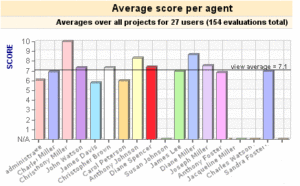An example of a call evaluation report.
Why record calls for training purposes?
By recording calls, a contact centre can build a tangible evidence-base against which they can consistently audit the quality of customer interactions. Having access to recordings means that an organisation can easily demonstrate and define what good and bad calls sound like in individual or group agent training sessions – whether that definition is geared around basic compliance, sales technique or more subtle facets such as tone and empathy.
Without access to call recordings, it is difficult to clarify what constitutes a good or a bad call. In a classroom environment, agents will find it hard to comprehend what they should say to customers – how they should phrase it and what tone they should use – if they do not have any examples to emulate.
Crucially, if a manager intends to undertake one-to-one evaluation and training without the benefit of call recordings, they risk instigating disagreements with agents because they will not be able to present any evidence as to why a particular call was unsuccessful. The agent may feel the manager is being subjective, which will make it difficult to enforce standards and could – in extreme circumstances – lead the agent to believe they are being bullied.
Challenges and solutions to recording calls for training
Although it needn’t be a significant challenge, contact centres do have a legal obligation under the Data Protection Act to let agents know that their calls are being recorded and that these recordings may be used for training purposes. This is easily surmounted, however, so long as the contact centre informs its agents either at the recruitment or induction stage that it will be recording calls for this purpose.
A more significant challenge is deciding which calls to pick for training from the vast volume that are recorded. According to Julia Whiteley, people and development director at outsourced contact centre Gasbox DMG, this can only be overcome if the contact centre gives trainers – be they dedicated coaches or team leaders – adequate time to sift through call recordings to create a reasonable sample for different individuals on different types of calls at different times of the day.
Sufficient time also needs to be provided to enable both agent and trainer to run through those recordings and discuss their merits and faults.
Training-related functionality in call recording kit
If contact centres want to record calls for training purposes, there are several pieces of functionality they might look for when purchasing call recording technology. These include:
1) The ability to integrate with the customer relationship management (CRM) platform, so enabling the trainer to not only retrieve calls but to replay them alongside screen shots of the CRM data that was manually keyed in by the agent at the time of the customer interaction. This provides a 360° view of the interaction and may uncover problems not apparent in the call recording alone – for example, inadequate or inaccurate data capture in the CRM system.
2) Integration with a quality monitoring (QM) application, so allowing the trainer to input quality scores on to a QM form that is directly linked to a specific call recording – one that can be immediately recalled alongside the call recording during training sessions. Many call recording systems have no such linkage and are reliant on the trainer capturing quality scores in Excel documents which are then stored separately to the call recordings. Retrieval of the relevant call recording and QM data can become protracted because of this and, in some instances, quality scores may be attributed to the wrong call recording, so creating obstacles to successful training.
3) The ability to integrate with customer feedback, such as that captured through post-call automated surveys. Again, this information should ideally be accessible in a single platform alongside CRM data and QM scores. It is useful because QM sometimes only provides an internal perspective on the merits and faults of an agent’s interaction with a customer. By correlating this with the customer’s own view of the call, the trainer will be able to assess and coach the agent more fairly.
4) Integration with speech analytics technology, which makes QM more robust by allowing the trainer to use word- or phrase-spotting and emotional detection to analyse specific calls more thoroughly. For example, speech analytics can identify phrases such as ‘so what?’, ‘I don’t care’ or ‘what do you want me to do about it?’ – thus helping identify agents who need more quality monitoring than may have been apparent through random sampling of call recordings.
Steps to developing a successful training strategy from call recordings
Contact centres that want to create a training strategy around their call recordings need to first consider their technical functionality – specifically, what level of integration they have with their CRM, QM and customer feedback platforms, or how easily these systems can be integrated with the call recording platform to provide a more consistent and holistic view of the customer experience.
After this, the actions contact centres might take are as follows:
1) Establish the strategic goals of the contact centre and how these can be met through analysis of and training from call recordings. Does the organisation want to increase first-contact resolution or drive revenue per call, for example, or decrease customer complaints?
2) Bearing in mind the strategic aims of the contact centre, determine how many call recordings should be assessed per agent – based on the overall agent population, call types and the volume of calls – to provide a realistic sample of each agent’s work in line with the organisation’s operational goals. This needs to be correlated with the budget for and availability of trainers – be they dedicated coaches or team leaders – to determine how much management time is required to source call recordings for training sessions and how much agent and management time is required for the training itself. It also needs to be correlated with the proposed frequency of call recording-based training sessions.
3) A sample of ‘good’, ‘bad’ and potentially ‘problematic’ calls need to be sourced from existing call recordings – again, based on the strategic goals of the contact centre – to provide a benchmark both for the first batches of one-to-one training and also for any classroom-based group activities such as induction training or team refresher courses.
4) If QM reporting isn’t already built into or integrated with the call recording platform, a QM form needs to be created using the benchmark call recordings. This form should be broken down into evaluation questions and scoring boxes based on the strategic aims of the contact centre. For example, if the contact centre’s primary aim is to decrease customer complaints, the form might evaluate first-contact resolution rates, agent knowledge of the product and/or services on offer, agent courtesy and rapport building, and whether the agent has used appropriate wording to finish the call.
5) Supporting QM processes also need to be established, including a formal plan of action should an agent dispute a training evaluation. Crucially, a calibration process should be put in place to ensure that trainers are scoring agents consistently. In some contact centres, calibration is achieved by having a central group that ‘checks the checkers’ – undertaking additional assessments of call recordings to ensure that they are being scored fairly.
Further reading
Contributors
- James King of Nice
- Business Systems (UK)
- Gasbox DMG
- NewVoiceMedia
- Sabio
- Verint
Author: Jonty Pearce
Published On: 3rd Apr 2010 - Last modified: 4th Jan 2023
Read more about - Call Centre Management, Business Systems, Call Recording, NICE, Sabio, Training, Vonage





















